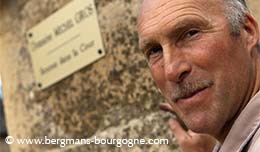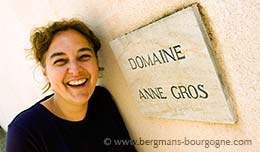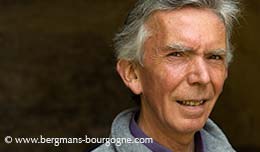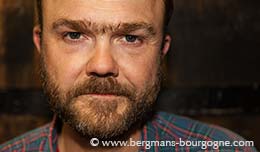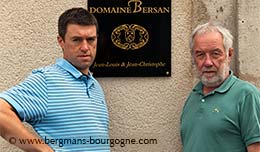
here was a time long ago, before the phylloxera crisis, when there were vineyards surrounding Noyers-sur-Serein. Today the vines are gone and there are only two growers around the village, both of which have their vineyards further up the road, in Chablis and in Irancy.
– There are no growers in the village itself, says Damien Bardet. There is another grower, who, like us, is located at a farm outside the village. Chablis is only 20 minutes away, so it is really only at harvest it becomes a bit complicated.
When it comes to wine Domaine Bardet is a relatively young estate. It was Damien Bardet’s father, Philippe Bardet, who together with his brother, Michel Bardet, decided to diversify the family business in the early 1990s. Up until then the family had been farmers, focusing on crops like wheat, rapeseed and barley, with a total surface area of 900 hectares.
 – My grandmother had some land in Préhy, explains Damien Bardet. It was not planted. So from 1992 to 2008 they planted the first six and a half hectares of the domaine. The first bottling was in 1994 and it was just 1000 bottles.
– My grandmother had some land in Préhy, explains Damien Bardet. It was not planted. So from 1992 to 2008 they planted the first six and a half hectares of the domaine. The first bottling was in 1994 and it was just 1000 bottles.
Since then Domaine Bardet has grown to cover nine hectares. The vineyards in Préhy produce both Bourgogne blanc and village appellation Chablis, as well as some Crémant de Bourgogne.
 – Préhy is actually the only commune in the Chablis area where you are allowed to produce Bourgogne blanc, continues Damien Bardet. But it is also the only Chablis commune which doesn’t have a premier cru. With the exception of our vineyard in Irancy everything is located in or near Préhy. We have five and a half hectares of Petit Chablis spread out over three communes – Préhy, Courgis and Chablis. We have two hectares of Chablis. The parcel of Bourgogne in Préhy is half a hectare and we also produce Crémant de Bourgogne from there. In Préhy we also have a vineyard with 40 year old vines for our old vines Chablis.
– Préhy is actually the only commune in the Chablis area where you are allowed to produce Bourgogne blanc, continues Damien Bardet. But it is also the only Chablis commune which doesn’t have a premier cru. With the exception of our vineyard in Irancy everything is located in or near Préhy. We have five and a half hectares of Petit Chablis spread out over three communes – Préhy, Courgis and Chablis. We have two hectares of Chablis. The parcel of Bourgogne in Préhy is half a hectare and we also produce Crémant de Bourgogne from there. In Préhy we also have a vineyard with 40 year old vines for our old vines Chablis.
By now Michel Bardet has retired and Philippe Bardet is about to follow. The place is run by Damien Bardet and his cousin Alexandre Bardet, the son of Michel. Because of the distance to Chablis the domaine now has a press in Préhy. At harvest the grapes are pressed there and then transported to the cuverie just outside Noyers-sur-Serein.
 – Vinification here is traditional, says Damien Bardet. Stainless steel tanks are used for most wines. It is temperature controlled. The Petit Chablis is usually bottled in May following the harvest. The Chablis is bottled just before harvest, while the old vines Chablis and the Irancy spend almost a year in tank.
– Vinification here is traditional, says Damien Bardet. Stainless steel tanks are used for most wines. It is temperature controlled. The Petit Chablis is usually bottled in May following the harvest. The Chablis is bottled just before harvest, while the old vines Chablis and the Irancy spend almost a year in tank.
The Petit Chablis parcels are all vinified separately and then blended before bottling. The Chablis is smaller in terms of surface area and therefore vinified as one single cuvée.
 – The Petit Chablis is ready to drink immediately, whereas the Chablis requires a bit of time, says Damien Bardet. The Petit Chablis is easy-drinking and you can keep it for two or three years.
– The Petit Chablis is ready to drink immediately, whereas the Chablis requires a bit of time, says Damien Bardet. The Petit Chablis is easy-drinking and you can keep it for two or three years.
– The Petit Chablis vineyards are a mix of Portlandian and Kimmeridgian soils. The Chablis vineyards are more Kimmeridgian. The soil is less deep there and there is less clay as well.
The Bourgogne blanc and Crémant de Bourgogne parcel in Préhy is located in the western part of the commune towards Saint-Cyr-les-Colons and the Paris motorway. It is not far from the Chablis vineyards, but the Bourgogne blanc is distinctly different in character.
 – Bourgogne blanc is fatter, says Damien Bardet. It’s thanks to the terroir. The Chablis is more mineral, while the Bourgogne is rounder. Both are made in tank.
– Bourgogne blanc is fatter, says Damien Bardet. It’s thanks to the terroir. The Chablis is more mineral, while the Bourgogne is rounder. Both are made in tank.
Many domaines in this part of Burgundy are very little involved in the production of the Crémant they sell. In many cases they just deliver their grapes to the co-operative Les Caves Bailly near Saint-Bris-le-Vineux and then later pick up the bottles. Domaine Bardet is different. The base wine is made at the domaine and then transported to Dominique Gruhier in Épineuil, who turns the still wine into sparkling. The Crémant de Bourgogne of Domaine Bardet is 100 per cent chardonnay.
 Domaine Bardet does not own any premier or grand cru land, but there is a small amount of Chablis premier cru Fourchaume – about 2000 bottles annually – bought in from another grower. Up until recently this was also the case with the Irancy of the domaine. From 2008 to 2017 it was produced from bought in grapes. In 2016 they eventually found some land to buy and plant, one hectare in Envers du Val Suzeau, which is a lieu-dit near the eastern limit of the appellation.
Domaine Bardet does not own any premier or grand cru land, but there is a small amount of Chablis premier cru Fourchaume – about 2000 bottles annually – bought in from another grower. Up until recently this was also the case with the Irancy of the domaine. From 2008 to 2017 it was produced from bought in grapes. In 2016 they eventually found some land to buy and plant, one hectare in Envers du Val Suzeau, which is a lieu-dit near the eastern limit of the appellation.
– I really like Irancy, says Damien. I love the pinot noir. There is also some césar in our Irancy. About five per cent (maximum allowed is 10%). The vines are still very young, so this is a wine to drink young.
Philippe Bardet comes by during the interview to see how things are going. For him the choice of moving into wine was an important one.
– Being a farmer or a winegrower are two completely different things, he says. Of course, in both cases you are working with plants. And if you are like some winegrowers in Chablis who sell their grapes immediately after harvest then there are similarities. But that was never our plan. We wanted to be involved in the whole process, from growing the grapes to delivering the wine in bottles to the customers. When you grow wheat you’re all alone all year around. Wine gives you a chance to have contact with the outside world. It’s a kind of recognition. Everybody needs a bit of that.
© 2020 Ola Bergman










